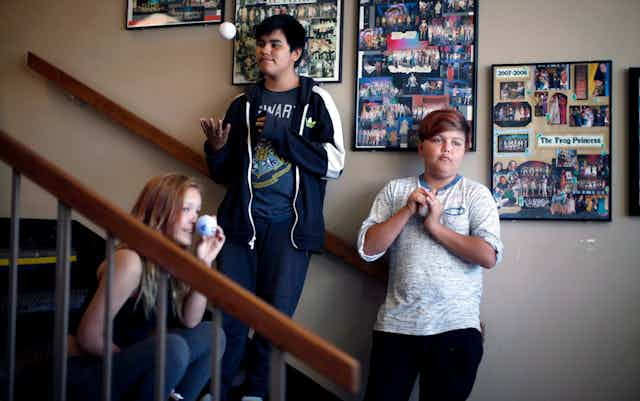Youth now represent nearly half the Indigenous population in Canada. These young people are at exciting times in their lives and many are planning to, or already do, attend post-secondary education.
As well, Indigenous entrepreneurship, in general, but especially for youth, has been on the rise since 2000. That business arena is growing at a rate that is six times faster than entrepreneurship among non-Indigenous people. Indigenous entrepreneurs tend to be about 10 years younger than their non-Indigenous peers.
These young people are in the early phases of their financial lives, and would likely benefit greatly from some practical financial literacy education.
One of the 94 Calls to Action by the Truth and Reconciliation Commission (TRC) is to develop culturally appropriate curricula to help Indigenous youth access information and achieve success. A culturally relevant approach to financial literacy education can help to address the financial literacy gaps that colonization has created.
While many personal finance books provide excellent content in terms of the mechanics of personal finance, they are not necessarily relevant to the values and experiences of all the students in the classroom. In particular, many financial literacy resources are not inclusive of Indigenous people and make no mention of their specific circumstances with regard to taxation, housing, banking and other personal finance topics.
Plus, they are expensive! According to CBC, textbook costs have risen some 834 per cent in the last three decades.
In 2016, I embarked on adapting an openly licensed textbook, Personal Finance, published in the United States to create a more affordable and culturally relevant personal finance literacy resource for Canadians. The result is Financial Empowerment.
Accessible personal finance
All people need to be able to see themselves in what they are learning. A 2015 study by a national Indigenous non-profit, focused on Indigenous finance, management and leadership, said that “culturally relevant educational materials” should be developed to “address the knowledge gaps…”.
During pre-contact times, Indigenous people had a rich economic history that demonstrated strong personal financial skills. But colonization, which created systems of control that led to social and economic exclusion, such as reserves, residential schools and the pass system, meant that many First Nations, Métis and Inuit communities experienced persistent cultural and systemic barriers that have significantly contributed to gaps in financial literacy.
The legislation and structures that were put in place attempted to control Indigenous people and create a system of dependency that denied many access to money and education in money management.
On Jan. 18, 2018, a federal roundtable on strengthening the financial literacy of Indigenous Peoples was held to bring together Indigenous and non-Indigenous organizations involved in financial literacy and financial capacity building. One of the directives that came from the roundtable was that financial literacy should be “culturally relevant, strength-based and community led by an Indigenous organization that can coordinate collective efforts.”
Critical to success
Financial Empowerment attempts to change these historic imbalances. It includes Indigenous perspectives, values and worldviews, with information from Elders so that Indigenous students can more deeply examine and understand their personal and cultural values surrounding money and how these values relate to their financial decisions and behaviours.
By beginning this conversation, I hope to make personal finance more relevant to Indigenous students in Canada and to also teach non-Indigenous students about Indigenous histories, perspectives and realities.
Writing in the Globe and Mail, Simon Brascoupé, co-chair of the newly-formed federal Financial Literacy Working Group for Indigenous Peoples says a strong foundation in financial literacy is critical to the success of Indigenous entrepreneurs. He recommends investing in education and training by and for Indigenous youth. He says this investment will help to tackle the many barriers when it comes to employment and successful skills training for Indigenous people.
Financial empowerment is not only about building personal finance skills and knowledge, but also about changing financial behaviour by understanding one’s values, attitudes, goals and practices regarding money. Sharing the wisdom and power of culturally relevant financial literacy education in Indigenous communities is one way to promote the success of Indigenous youth.

